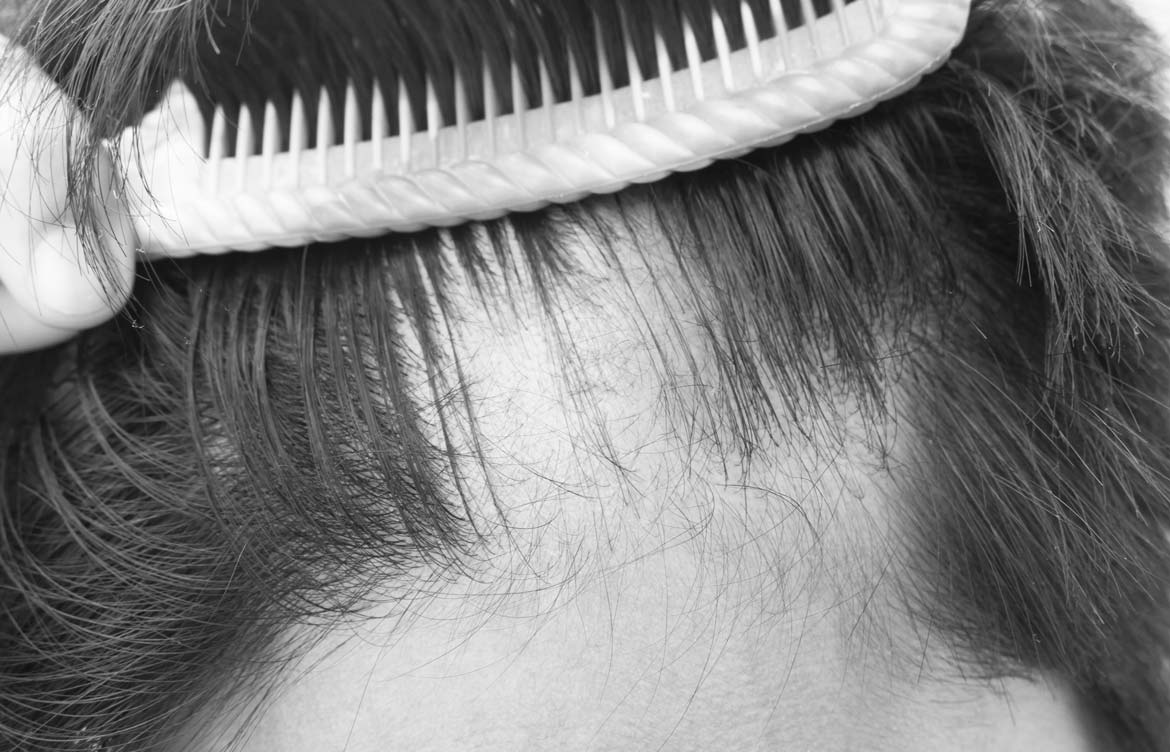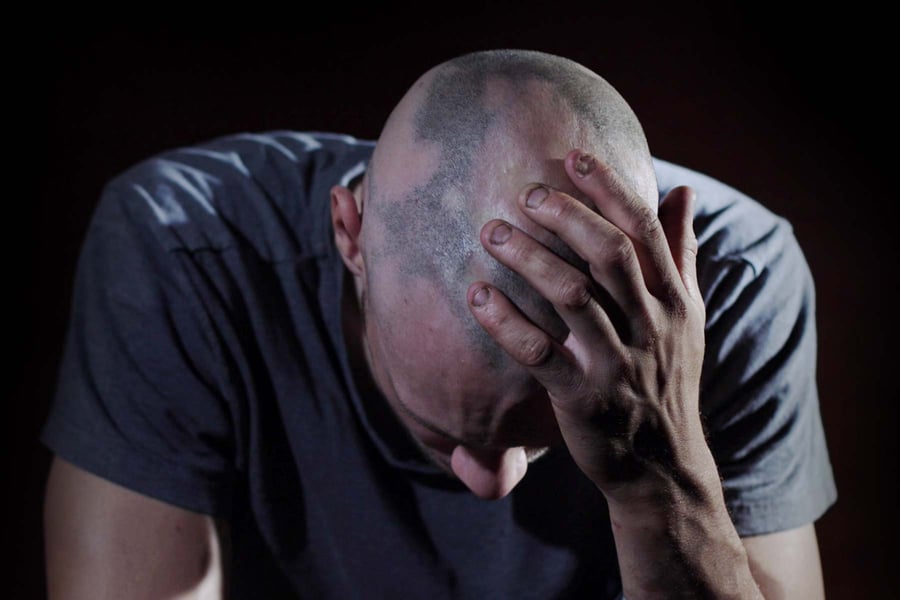What are the Signs & Symptoms of Alopecia Hair Loss?

It's natural to panic when you realize your hair isn't as thick as it used to be. But before you start frantically Googling alopecia symptoms, it's important to understand what this autoimmune condition is—and isn't.
Alopecia is the medical term for hair loss that happens when your body fights against its follicles, causing hair to fall out or stop growing. While it usually occurs on the head, it can happen anywhere on the body.
There are several different types of alopecia, but the most common types are:
- Alopecia Areata: This type of alopecia usually starts with one or more small, round bald patches on your head and can eventually lead to complete hair loss. It's often accompanied by nail changes, such as pits or ridges.
- Alopecia Totalis: This is a more advanced form of alopecia areata, which leads to complete hair loss on the scalp.
- Alopecia Universalis: The most severe form of alopecia, this type causes all hair on the body—including eyebrows and eyelashes—to fall out.
While it can affect just about anyone, the early signs of alopecia can manifest differently in men and women. In this piece, we'll explain the beginning signs of alopecia in both sexes, causes, and the best treatments so you can get your hair—and your confidence—back.
symptoms of alopecia in females

In our society, hair is synonymous with femininity—which is why alopecia can be such a blow to a woman's self-esteem.
The early signs of alopecia in women are often subtle and can be easy to miss if you're not paying close attention. By proactively checking for the following alopecia symptoms, you can catch the condition early on and get started on treatment as soon as possible. If you notice any of the following symptoms, report them to your doctor immediately.
Broadening Part
Most of us don't give our part much thought, but it can actually give you a keen insight into the state of your hair. A wider part is one of the most common beginning signs of alopecia in women. Use a handheld mirror to regularly check the width of your part.
Receding Hairline
A receding hairline is one of the more noticeable alopecia symptoms, but it's often chalked up to aging—when in reality, it could be an early sign of alopecia. If you notice your hairline gradually moving back or your temples appearing to shrink, it could be a warning sign of alopecia.
Hair Thinning
It's normal to lose 50-100 hairs a day, but regularly finding more than that in your brush or on your pillow could mean alopecia is to blame. Slowly thinning hair is one of the earliest alopecia symptoms, so be vigilant about noticing changes in your hair's texture or density.
Round Bald Patches
Even a quarter-sized bald spot on your scalp can signal that something's off, especially if it's round-shaped. These patches are a hallmark alopecia symptom.
Hair Clumping
When you run your fingers through your hair, do several strands come out at once? These alopecia signs—known as "clumps"—are incredibly alarming and hard to miss.
Excess Hair in Your Brush or Drain
Hair loss can be difficult to spot if you don't know what to look for, but if you're constantly clogging your drain or finding an abnormal amount of hair in your brush, alopecia may be to blame. Don't ignore these commonly overlooked red flags. The sooner you get a diagnosis, the better.
Total Hair Loss
And finally, one of the most severe alopecia symptoms is total hair loss. If you've lost all the hair on your scalp—or all the hair on your body—it's time to seek medical attention. With the proper diagnosis and treatment, you can start on the road to regrowth.
Symptoms of alopecia in males

Losing your hair can be just as devastating for men as it is for women. While baldness is more socially acceptable in men, it can still cause a significant blow to your self-esteem—especially if you're young.
While early signs of alopecia in males are similar to those experienced by females, there are a few key ways in which they differ. Pay close attention to the following signs and symptoms of alopecia so you can catch it early on and start treatment ASAP.
Receding Hairline
One of the most commonly seen alopecia symptoms in men is a receding hairline. This can happen gradually or suddenly, and it's often the first symptom that men notice. If your hairline has changed shape or you've developed a "widow's peak," talk to your doctor.
Bald Spots on the Back of Your Head
They may be hard to spot if you're not used to looking at the back of your head in the mirror, but bald spots are a telltale sign of alopecia. These patches are often small—about the size of a coin—but they can grow larger over time.
Patchiness
Patchiness is when your hair starts to thin out in certain spots, usually around the temples or crown. While these small areas won't be completely bald, the hair will be sparse enough to see your scalp through.
Hair Thinning
Usually, the first sign of hair thinning in men is a change in texture (i.e., the hair becomes finer and weaker). If you notice your hair is thinner than it used to be, bring it up with your doctor.
U-Shaped Pattern Around the Sides
When a hair line continues to recede inward towards the center of the scalp, it can create a "U" shape pattern of hair around the sides. This is just one of many shapes alopecia symptoms can take, with an "O" or "M" shape being others.
Total Hair Loss
If left untreated, the condition can progress to complete hair loss—a.k.a., alopecia totalis. This is when all the hair on your head falls out, leaving you completely bald. Fortunately, even men with complete hair loss can regrow their hair with the right treatment. While it may take some time, it is possible to restore your head—and your confidence—back to its former glory.
what causes alopecia?
Unfortunately, there's no singular cause you can point your finger at when it comes to alopecia. A multitude of factors—both genetic and environmental—can play a role in the development of the symptoms of alopecia.
Genetics
Alopecia is often hereditary, meaning it's passed down from one or both of your parents. If someone in your family had or has alopecia signs, you're more likely to develop it yourself.
Hormonal Changes & Medical Conditions
Out-of-whack hormones and certain medical conditions can also trigger the early onset of alopecia. In women, hair loss happens when testosterone and estrogen are out of balance. In men, it's usually due to high levels of DHT.
Hormonal imbalances are common in postpartum women, menopausal women, or women taking birth control pills. And while any medical condition can theoretically cause hair loss, autoimmune diseases like lupus and psoriasis are the most likely culprits.
Medications & Supplements
Certain medications and supplements are also linked to hair loss, including:
- Beta-blockers and other blood pressure medications
- Antidepressants
- Immunosuppressants
- Vitamin A
- Anticoagulants
- Antibiotics
- Weight loss drugs
- Chemotherapy
Radiation Therapy to the Head
If you've recently undergone radiation therapy to the head to treat cancer, it's not uncommon for hair loss to occur a few weeks later. This is usually temporary, and your hair will grow back once treatment has ended.
Stress & Anxiety
Last but not least, stress and anxiety can also cause hair loss. This is because when you're stressed, your body goes into "fight or flight" mode and conserves the energy necessary for survival. This includes shutting down non-essential functions like hair growth.
Hairstyles & Treatments
Certain hairstyles and treatments can also lead to hair loss. We're talking things like:
- Tight ponytails, braids, or cornrows
- Hair extensions
- Relaxers
- Hot oil treatments
Consistently wearing your hair in a tight style can stress the follicles and lead to traction alopecia. This is a type of alopecia that's caused by damage to the follicles from constant pulling or tension.
Similarly, chemical treatments like relaxers and hot oil treatments can also damage the follicles and lead to hair loss.
We now know what causes alopecia, so what can you do about it?
HOW TO TREAT ALOPECIA
If you're experiencing early signs of alopecia, the first step is to visit a doctor or dermatologist. They can diagnose your condition and rule out any other potential causes of hair loss.
Once you've been diagnosed, there are a few different treatment options available to minimize alopecia symptoms, regrow lost hair, or conceal your hair loss.
Minoxidil
Minoxidil is an FDA-approved topical treatment that's available over the counter. It's applied directly to the scalp and is thought to stimulate hair growth by widening blood vessels and increasing blood flow to the follicles. Minoxidil can take up to four months to show any results.
While it's one of the most popular hair regrowth treatments available, it doesn't work for everyone. You have to have the SULT1A1 enzyme to metabolize minoxidil, and not everyone has it. You can save yourself some time (and frustration) by taking our Minoxidil Response Test.
Finasteride
Finasteride is the only other FDA-approved hair loss treatment. It's a daily oral medication that's only available with a prescription. Finasteride works by blocking the hormone DHT, which is thought to play a role in follicle miniaturization (a.k.a. hair loss).
Finasteride is most effective in men with androgenic alopecia or male pattern baldness. While some doctors will prescribe it for women, it's not safe to take if you're pregnant or plan to become pregnant as it can cause birth defects.
Baricitinib
The newest player on the hair loss treatment market is Baricitinib. This oral medication was originally developed to treat arthritis, but it's shown promising results in treating severe alopecia areata. It's the first treatment of its kind to receive FDA approval as it treats the entire body—not just the scalp.
PiliLock Sevilla Orange Complex (Intact)
When you're trying to regrow your lost hair, the last thing you want is to lose more. The PiliLock Sevilla Orange Complex used in Daniel Alain's signature anti-shedding treatment is clinically proven to protect your existing hair from daily shedding activities like brushing, washing, and styling.
Hair Transplant
Sometimes, a hair transplant is the best option to treat the symptoms of alopecia. This is a surgical procedure where healthy hair follicles are taken from another area of your scalp and transplanted to the balding or thinning areas.
A hair transplant can give you natural-looking results, but it's an expensive and invasive procedure. It's also not an option for everyone as you need to have enough donor hair to transplant.
Platelet Rich Plasma Therapy (PRP)
PRP therapy is a non-surgical treatment option that uses your blood to stimulate hair growth. A small sample of your blood is taken and then placed in a centrifuge, which separates the platelets from the other blood cells. The platelets are then injected into your scalp, where they activate growth factors that stimulate hair growth and reduce alopecia signs.
PRP therapy is a newer treatment option, so there's little research to support its efficacy. However, preliminary studies have shown promise, and it's considered a safe treatment with minimal side effects.
Laser Phototherapy
Low-level laser therapy (LLLT) is another non-surgical treatment option. It uses low-level lasers to stimulate hair growth by increasing blood flow and energy production in the cells. LLLT is typically done in either a professional setting or at home with a handheld device.
There's some evidence to support using LLLT for hair loss, but more research is needed to confirm its efficacy.
Scalp Micro-pigmentation
Scalp micro-pigmentation (SMP) is a cosmetic procedure that can give the appearance of a fuller head of hair. It's done by injecting pigment into the scalp to create the illusion of hair follicles. SMP is not a permanent solution, as the pigment will eventually fade.
WHAT ELSE YOU CAN DO IF YOU ARE SUFFERING FROM ALOPECIA
While it'd be great if you could snap your fingers and wake up with a full head of hair, alopecia treatments don't always work that way. In most cases, they need to be used long-term to see results.
The good news is that there are things you can do to help manage your alopecia while feeling confident in your hair, whether that’s your bio hair or a fabulous hairpiece.
Wear a High-Quality Human Hair Wig
If you're dealing with hair loss and alopecia signs and symptoms, one of the best things you can do is invest in a high-quality human hair wig. You can style them with the same tools and treatments you use on your regular hair, and they give you the freedom to try different styles.
A human hair wig—especially the luxury European wigs from Daniel Alain—can give you the confidence to face the world with hair loss.
Blend Your Natural Hair With a Topper
If you're not ready for a wig or your symptoms of alopecia are milder, a topper is a great option. Toppers are small hairpieces that sit on top of your head and blend in with your natural hair. They come in various colors, textures, and lengths to match your natural hair, and they're a less expensive option than a wig.
Toppers are easy to put on and take off, and they give you the option to style your hair in different ways. You can also use them to add volume or cover up specific areas of hair loss.
Just make sure you opt for a human hair topper, as synthetic hair won't blend as well and can look unnatural.
Start your hair regrowth journey today at daniel alain
No one should suffer from alopecia in silence. Here at Daniel Alain, we offer a variety of different hair loss treatments to help you regain your confidence. From our clinically proven anti-shedding treatment to our premium human hair wigs, we're here to help you every step of the way—no matter what stage of the hair loss journey you're experiencing.
Schedule a free consultation with us today and discover which treatment option is right for you!
book a free consultation
Our stylists will help you find the right hair loss solution just for you

Frequently Asked Questions
What is Alopecia?
Alopecia is the medical term for hair loss. It can be caused by various factors, including genetics, autoimmune disease, stress, and certain medications. There are several different types of alopecia, and each one has its own set of symptoms
What Types of Alopecia are There?
There are five different types of alopecia: androgenic alopecia, alopecia areata, alopecia totalis, traction alopecia, and alopecia universalis. They each have specific signs of alopecia hair loss.
Androgenic alopecia is the most common type of alopecia. It's characterized by:
- A receding hairline in men
- A widening part in women
Alopecia areata is an autoimmune disorder that causes patchy hair loss. It's characterized by:
- Round, bald patches on the scalp
- Other bald patches around other parts of your body
Alopecia totalis is a more severe form of alopecia areata. It's characterized by:
- Complete hair loss on the scalp
Traction alopecia is caused by damage to the hair follicles through repetitive pulling or stretching (usually from tight hairstyles). It's characterized by:
- Thinning hair
- Patchy bald spots, specifically near the area where the hair is pulled tight
Alopecia universalis is the most severe form of alopecia areata. It's characterized by:
- Complete hair loss on the scalp
- Complete hair loss on the rest of the body
How Do You Know if You are Getting Alopecia?
If you're noticing any hair loss, it could be the result of some form of alopecia. Be vigilant of any changes in your hair and signs of alopecia, including:
- Thinning hair
- Bald spots
- Receding hairline
- Widening part
- Complete or sudden hair loss on the scalp or body
If you're experiencing any of these symptoms, see a doctor or dermatologist as soon as possible. They will be able to diagnose the type of alopecia you have and recommend the best course of treatment.
Who is Affected by Alopecia?
Alopecia can affect anyone, regardless of age, race, or gender. However, most people develop alopecia signs and symptoms by the age of 30.
What Age Does Alopecia Usually Start?
Alopecia can develop at any age, but most people start to experience it in their 30s.
Can Alopecia Be Cured?
There is no cure for alopecia, but there are treatments available that can help stop the hair loss and even regrow some of the lost hair. If you want to hang on to the strands you have, an anti-shedding treatment like INTACT will help prevent further hair loss.
How Do You Stop Alopecia From Spreading?
There is no surefire way to stop alopecia signs and symptoms from spreading. However, if you catch it early and treat it effectively, you may be able to prevent it from getting worse. Anti-shedding treatments like INTACT (which is clinically proven) can help you keep the hair you have while you work to regrow some of the hair you've lost.
Will Alopecia Go Away on its Own?
Some forms of alopecia will go away on their own, depending on the cause. Stress-induced hair loss, for example, is often temporary and will resolve itself once the stressor is removed. Hair loss caused by medication will also usually grow back once the medication is stopped.
How Long Can Alopecia Last?
How long you'll experience alopecia signs and symptoms depends on the root cause of your hair loss. Still, most types of alopecia are lifelong conditions, which means you'll need to manage them with ongoing treatment.
How Quickly Does Hair Fall Out with Alopecia?
There is no clear-cut answer to this question since everyone experiences hair loss at different rates. Some forms of alopecia can cause hair to fall out very quickly (in patches or all over the scalp), while others are more gradual.
Once you notice the first signs of alopecia, it's important to see a doctor or dermatologist so they can diagnose the type of hair loss you're experiencing and recommend the best course of treatment. With early intervention, you may be able to prevent further hair loss.
Does Hair Grow Back After Alopecia?
It depends on how early you catch the alopecia and what type you have. With proactive treatment, some forms of alopecia can be reversed, and the hair will grow back.
Is Alopecia a Sign of Cancer?
No—alopecia is not a sign of cancer. Cancer patients may experience hair loss as a side effect of chemotherapy, but alopecia itself is not indicative of cancer. So if you experience signs of alopecia hair loss, there’s no need to panic.
Is Alopecia Life Threatening?
No—alopecia is not life-threatening. However, it can be emotionally distressing for some people and may lead to mental health issues. If you're struggling to cope with your hair loss, wearing a wig or a topper can help you feel more comfortable in your own skin.
How Often Should I Wash My Hair with Alopecia?
Washing can cause even more hair to fall out, especially for those with alopecia. Keep your shampoo-ing down to two to three times per week to minimize hair loss. Be gentle when washing and avoid using harsh chemicals or heat treatments, as these can further damage your hair.
INTACT is a safe and effective anti-shedding treatment that helps prevent hair loss and shedding during damaging activities like washing. Just put it on a half hour before your shower, and it will help safeguard your strands!
How Do You Diagnose Alopecia?
If you're experiencing hair loss or signs and symptoms of alopecia, the first step is to see a doctor or dermatologist for a proper diagnosis. They will likely perform a physical examination and look at some hair samples under a microscope. They may also order tests to rule out other conditions.
When Should I See a Doctor for Alopecia?
If you're concerned about hair loss, it's best to see a doctor or dermatologist as soon as you notice the first signs of alopecia. Early intervention is key to preventing further hair loss.

